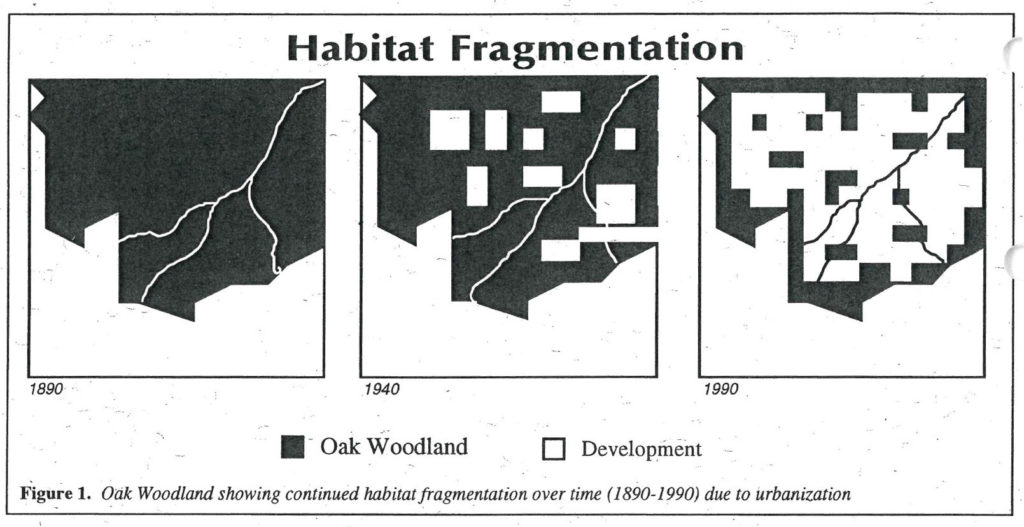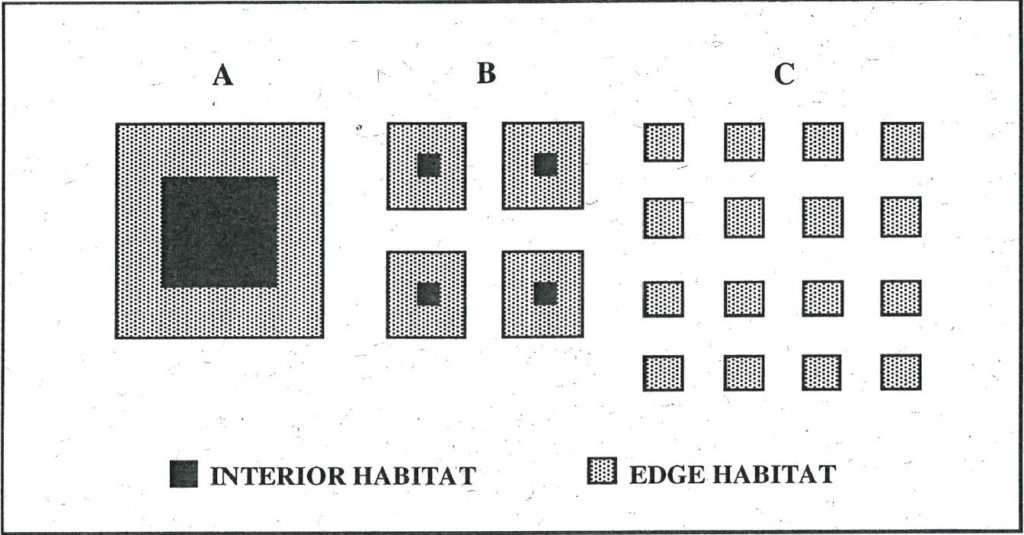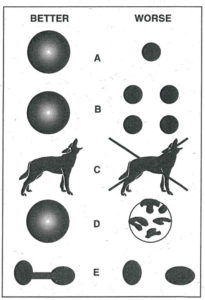Oaks ’n’ Folks – Volume 3, Issue 1 – January, 1996
Applying the Concepts of Landscape Ecology Using GIS Technology and the CDF Oak Woodland Maps
Californians value oak woodlands for their aesthetic, natural resource and economic significance. Over the past several decades, residents have expressed increasing concern, however, over the loss of oak woodland wildlife habitat. The leading cause contributing to loss and degradation of habitat values is residential development.
Oak acorns, leaves, sap, and wood provide food for a multitude of mammals,birds, reptiles, amphibians, insects, and other wildlife. Along with food,oak communities contain the nooks, crannies, perches, and passages where animals eat, drink, reproduce, and find shelter. Oak woodland habitat provides variety and a wealth of micro-habitats for wildlife to thrive. As we gain a better understanding of how residential development impacts wildlife habitat,we increase the possibilities for conserving California’s oak woodlands or future generations.
Landscape Ecology Concepts
Over time, development activities may break up formerly large portions of oak woodland into progressively smaller pieces, diminishing its natural resource values, including its suitability as wildlife habitat (figure 1).Landscape ecologists term this process “habitat fragmentation.”Some wildlife, especially the more mobile mammals and birds, can use habitat fragments. Fewer than 25% of the terrestrial vertebrate wildlife found in oak woodlands, however, can live in a fragmented environment. The remaining 75%, which are unable to adapt, may experience declines in population size.

Landscape Ecology Definitions
Habitat Fragmentation – The process by which contiguous large blocks of habitat are broken or sliced into progressively smaller pieces by housing and industrial development, intensive agriculture, roads,and other development activities.
Patch – A surface on the landscape differing in appearance from its surroundings. Patches may be due to natural (e.g., soil type) oranthropogenic (human-caused; e.g., housing development) factors. Areas of oak woodland, chaparral, or residential development are examples of patches within a landscape.
Edge Habitat – The outermost band surrounding a patch that has an environment significantly different from the interior of a patch.Edges can be a few to several hundred feet wide depending on environmental factors.
Interior Habitat – Habitat within the interior of a patch that is removed from edge habitat. Interior habitat is necessary for certain oak woodland species, providing insulation from edge effects such as noise,wind, solar radiation, and increased predation.
Corridor – A strip of land that differs from the surrounding area on both sides. The strip of habitat along a stream or road, a windbreak,a road, or railroad right-of-way are examples of natural and human-designed corridors that may function as habitat connections between patches.
Landscape – A heterogeneous land area composed of a cluster of patches. Landscapes can contain patches of human development and wildlife habitat and vary considerably in size, shape, and structure.
Today, local planners frequently ask the following complex ecological questions:
- What is the smallest habitat patch required by wildlife?
- How does patch size and shape affect wildlife?
- What are edge species and interior species?
- What is a corridor and what is its value to wildlife?
- What minimum buffer dimensions are needed around patches and corridors to minimize the impact of residential development?
Although complete and easily applied answers to these questions are currently available, much has already been learned. Consensus is emerging among landscape ecologists on ways to minimize and mitigate the adverse impacts of residential development on wildlife habitat.
Consequences of Habitat Fragmentation
Many animals require a variety of habitat patches, in close proximity,to meet their daily and seasonal needs. A deer may bed down beneath the canopy of an oak, seek cover from predators within the thickets of riparian willows, drink from a nearby stream, and leave the shelter of the trees to forage in adjacent grassland. This variety of vegetation types forms a patch-work quilt across the landscape. The size, vegetation diversity, and interconnectedness of patches that make up the landscape, determine the population size and kinds of animals found within it.
For example, landscapes less than 250 acres (2.5 acres = 1 hectare) may support only a certain suite of species. The area may not be large enough to include a diversity of habitat patches or meet the home-range requirements of certain types of wildlife. Small, less mobile animals may be able to survive because their home-range requirements are small, however, survival of medium-sized animals is compromised over time and large animals can be rare or transient. Furthermore, when development activities isolate small areas of woodland habitat, resident wildlife populations also become isolated,eventually reaching a point where loss of a species from an area becomes a real possibility due to inbreeding and restricted gene flow.
A landscape of interconnected patches between 250-12,000 acres begins to approach sufficient size to support populations of medium-size animals such as coyotes, bobcats, and hawks. At this size, the region may encompass the variety of habitats these animals need to live and reproduce.
Landscapes greater than 12,000 acres, begin to protect ecosystem integrity and function. These large areas not only supply a multiplicity of diverse habitat types for large mammals and birds; in addition, a full range of small- and medium-size animals are provided quality habitat.
These landscape size categories (< 250 ac, 250-12,000 ac, > 12,000 ac) are based on information from interviews with experts specializing in research on wildlife habitat size requirements and landscape ecology concepts.The categories are based on habitat requirements of wildlife from the Eastern United States and Southern California. To date, information on patch-size requirements for oak woodland wildlife is limited, and it is not known how well these designations apply.
Edge and Interior Areas are Affected by Patch Size and Shape
Patch Size and Shape
The size of a habitat patch measurably affects the kinds and numbers of animals within the patch. Therefore, the species profile within a patch is at least partly a function of how we reduce and enlarge habitat as a consequence of designing and constructing on the landscape. Small patches have been likened to “islands” floating within a sea of development and are typically too small or too isolated to provide resident wildlife with the basic necessities of life: food, water, and cover.
The shape of a habitat patch causes similar effects to those of patch size, since shape also influences the relative amounts of edge and interior habitat. As a patch is reshaped from circular to linear, the distance from the interior to the edge decreases, as it does when a patch becomes smaller. For example, a long, thin patch caters almost exclusively to edge species because it provides little or no interior habitat. In contrast,a round patch of equal area may provide interior habitat.
Edge and Interior Habitat

Small habitat pieces favor edge species at the expense of interior wildlife species. The smaller patches provide relatively more edge habitat. For example,imagine a woodland patch of 16 acres divided into 4 smaller patches, and then divided further into 16, one-acre patches (figure 2). The amount of edge increases dramatically while the amount of interior habitat decreases until finally the patch is all edge.
Edge habitat benefits only certain kinds of wildlife such as opossums,raccoons, deer, skunks, cowbirds, and red-tailed hawks-often at the expense of interior habitat species, such as coopers hawks, bobcats, vireos, and thrushes-which mostly avoid edges. Highly mobile predators, such as mountain lions, will move through edge habitat in search of food, however, they depend on large patches for the cover and reproductive habitat the interior provides.
Corridors and Connectedness
The path that a river or stream follows is an example of a natural habitat corridor. Roads, both rural and urban, windbreaks, and railroad right-of-ways can also function as corridors. The strips of vegetation along streams are especially important to seasonally migrating wildlife. From a habitat perspective,these examples of natural and human-designed corridors may function as connectors of two or more patches of habitat. A habitat connection may make an otherwise isolated and unused patch into usable habitat. For example, recent research has shown that a mountain lion population of 15-20 adults requires, on average,625 square miles (1 km2 = 0.39 mi) of unfragmented habitat. If a corridor is available, however, to allow movement of mountain lions between patches,an area of about 430 square miles (about 30% smaller) can support a mountain lion population, lessening the risk of local extinction.
Corridors-both natural and human designed-provide linkage between patches creating a mosaic of habitats or vegetation types. Maintaining or creating corridors to link patches can increase usable wildlife habitat, provide dispersal and migration avenues, facilitate gene flow between populations,and increase the likelihood the patches will be inhabited. To be effective,however, a corridor must be of adequate size to provide food, water, and shelter to meet an animal’s needs as it moves within the corridor.
E. Maintain or develop corridors to link habitat patches. Corridors frequently lessen the deleterious effects of habitat fragmentation.

A. Maintain large-size patches to provide a variety of habitat types and minimize edge effects.
B. A single large patch is usually better than several small fragments.
C. As much as possible, retain large carnivores in oak woodlands. Studies show that coyotes, bobcats, and mountain lions limit the numbers of smaller predators, such as feral cats and introduced foxes, that prey on some native wildlife.
D. Minimize human disturbance. Excessive numbers of trails and roads through open space accelerate the invasion of weedy species of plants and increase the amount of edge and edge effects: predation, noise, and excessive numbers of a few kinds of wildlife.
William Tietje and Tristan Berland
